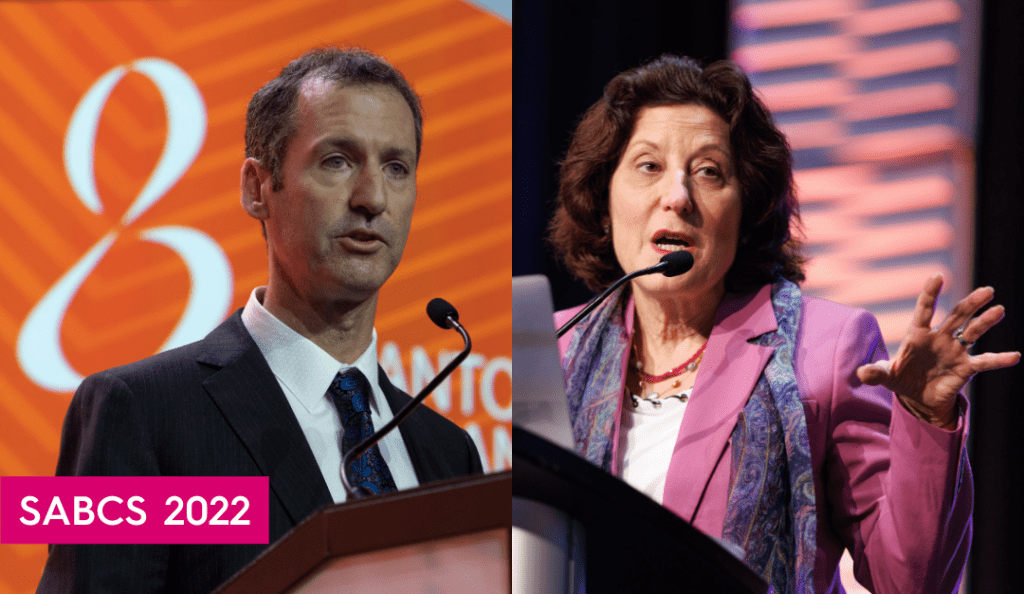Latest updates confirm the long-term benefit of these agents
At the 45th annual San Antonio Breast Cancer Symposium (SABCS), there was palpable excitement surrounding antibody-drug conjugates (ADCs). Researchers presented results of follow-up studies at this year’s symposium on the heels of recent successes with ADCs for breast cancer and with an eye toward potentially broadening their use to treat more patients with breast cancer.
Here, we summarize these updates regarding this hot topic from SABCS.
A closer look at antibody-drug conjugates
Although ADCs have been around for decades, the FDA recently approved three for treating breast cancer including triple-negative (TNBC) and metastatic breast cancers: ado-trastuzumab emtansine (T-DM1/ Kadcyla®), trastuzumab deruxtecan (T-DXd/Enhertu®), and sacituzumab govetican (SG/ Trodelvy®).
So, what exactly are ADCs? Basically, they are advanced therapies that precisely deliver drugs to cancer cells with substantially less toxicity to normal cells. They are composed of three parts: an antibody, a drug or payload, and a linker that connects the antibody to the drug. The power of ADCs lies in the specificity of the antibody that recognizes and binds to its tumor cell specific target, the transient nature of the linker, and the strategic release of a potent drug at the tumor cell site to affect the target cells and, potentially, surrounding tumor cells as well (a process known as bystander effect).
The development of ADCs has been up and down through the years, but technological advancements have enabled researchers to engineer successful combinations of antibodies and drugs. The composition of these three ADCs for breast cancer illustrate the strategies behind their development:
- T-DM1: The antibody trastuzumab is linked to the drug (payload) emtansine. Trastuzumab binds HER2 proteins found on HER2-positive breast cancer cells and delivers a drug that prevents the targeted tumor cells from growing.
- T-DXd: Trastuzumab is the antibody portion linked to the drug deruxtecan. Trastuzumab binds to HER2 on breast tumor cells bringing the payload—a topoisomerase 1 inhibitor that blocks tumor cells’ DNA repair—directly to the tumor cells.
- SG: The antibody, sacituzumab, is linked to the drug SN-38. Sacituzumab targets the TROP-2 protein found on all subtypes of breast cancer cells. The antibody binding to TROP-2 results in the release of the payload SN-38 (another, more potent topoisomerase 1 inhibitor) to breast tumors. Importantly, this can be used for triple-negative breast tumors, which have fewer treatment options.
Clinical results with T-DM1 garnered great enthusiasm in the breast cancer research community and led to its FDA approval as the first ADC for treating metastatic HER2-positive breast cancer. Similarly, promising results from clinical trial testing of SG led the FDA to approve it as the first ADC for treating metastatic TNBC.
Following development T-DXd’s development, a series of trials (DESTINY-Breast) were launched to test its efficacy and adverse effects. Importantly, DESTINY-Breast03 tested T-DXd in a head- to-head comparison with T-DM1 and demonstrated T-DXd’s advantages.
Researchers did not stop there. They are steadily working to ensure that long-term treatment with ADCs continues to benefit patients with no additional adverse effects.
Follow-up studies continue the excitement surrounding ADCs’ use in the clinic
BCRF investigator Dr. Ian Krop provided three-year follow-up results for the DESTINY-Breast02 trial in HER2-positive unresectable and/or metastatic breast cancer previously treated with T-DM1. He reported that T-DXd benefit was sustained over this time and significantly reduced the risk of progression or death compared to other treatments (physician’s choice) with no new adverse effects.
DESTINY-Breast03 investigators reported remarkable results from their two-year follow up with T-DXd versus T-DM1 treatment in patients with advanced breast cancer previously treated with trastuzumab and a taxane. T-DXd significantly reduced patients’ risk of death by a whopping 36 percent while promoting progression-free survival four times longer than that observed for T-DM1.
Recently, T-DXd hit the scientific airwaves with the outstanding results from the DESTINY-Breast04 clinical trial. Its efficacy in patients with HER2-low breast cancer was an exciting observation that could mean better outcomes for a larger number of people. Extended analysis of DESTINY-Breast04 patients presented at SABCS confirmed T-DXd’s longer-term benefit in HER2-low breast cancer with no additional adverse effects after two years.
At SABCS, BCRF investigator Dr. Hope Rugo also reported follow-up analysis of the TROPiCS-02 phase 3 trial that confirmed SG (the Trop-2-specific ADC) is an effective novel treatment option for certain patients independent of the levels of Trop-2 on their tumor cells. Its advantage, compared to treatment of physician’s choice, was maintained for 10 to 12 months without the need for prior testing of Trop-2 levels in patients with endocrine-resistant hormone receptor–positive/HER2-negative locally recurrent or metastatic breast cancer.
What’s next
Research continues to expand the arsenal of ADCs for treating breast cancer, and right now there are 17 ADCs in clinical trials. Nine HER2-directed ADCs are being tested in combination with novel payloads, and eight ADCs are being studied in combination with novel antibody targets.
In addition, researchers are steadily working on ways to match the right ADC to the right patient, assess how combinations and sequencing of ADCs can augment their efficacy, identify biomarkers to predict how patients will respond, and gain a better understanding of mechanisms of resistance. We are in an exciting era of ADC therapy for breast cancer.






